History
Class 480 cars were ordered by BVG because the Class 475 trains, which had been taken over from Deutsche Reichsbahn (DR) when BVG took control of the S-Bahn in West Berlin in 1984, were inadequate for use in West Berlin and were outdated. Both ends of a four-unit Class 480 train has a driving cab, allowing the flexibility of having two multiple units together. Four prototypes were delivered in 1986. Additional trains were ordered in order to cope with the five additional routes reopened after re-unification in 1989, which increased the West Berlin's S-Bahn to 117 km (73 mi).
As a result of in incident in the Nord-Süd Tunnel in August 2004, in which the last vehicle in a train was destroyed by fire, class 480 trains were removed from routes S1, S2 and S25, Bringing Class 481 trains into the service on these routes ahead of plan. These trains were redeployed to other lines such as S41, S42, S45 and S8. S85 also decided to use these trains.

Pankow is the most populous and the second-largest borough by area of Berlin. In Berlin's 2001 administrative reform, it was merged with the former boroughs of Prenzlauer Berg and Weißensee; the resulting borough retained the name Pankow. Pankow was sometimes claimed by the Western Allies to be the capital of the German Democratic Republic, while the German Democratic Republic itself considered East Berlin to be its capital.
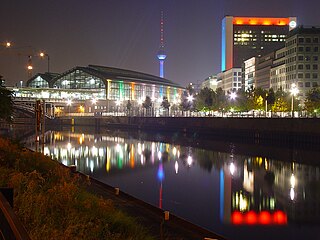
The Berlin S-Bahn is a rapid transit railway system in and around Berlin, the capital city of Germany. It has been in operation under this name since December 1930, having been previously called the special tariff area Berliner Stadt-, Ring- und Vorortbahnen. It complements the Berlin U-Bahn and is the link to many outer-Berlin areas, such as Berlin Brandenburg Airport. As such, the Berlin S-Bahn blends elements of a commuter rail service and a rapid transit system.
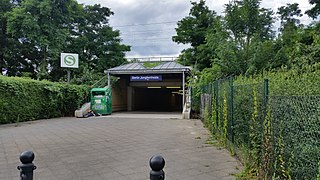
Berlin Jungfernheide is a railway station located at Charlottenburg-Nord, in the Charlottenburg-Wilmersdorf district of Berlin, served by the S-Bahn lines S41 and S42, the U-Bahn line U7 and Regional-Express trains of the Deutsche Bahn. Its name literally translates into "maidens' heathland"; it was named after the Jungfernheide, a former large forest in the proximity of this station.
S26 is a line on the Berlin S-Bahn. It runs from Teltow in the district (Kreis) of Potsdam-Mittelmark via Südkreuz, through the Berlin Nord-Süd Tunnel with a stop at Friedrichstraße, and ends in Waidmannslust in the borough of Reinickendorf. On weekends the S26 runs from Teltow to Potsdamer Platz.

Berlin Frankfurter Allee is a railway station situated on Frankfurter Allee in the Friedrichshain district of Berlin, close to the district's border with Lichtenberg. It is served by the S-Bahn lines S41, S42, S8, S85 and the U-Bahn line U5.
The S86 was a line number used by the Berlin S-Bahn.
The S6 was a line number used by the Berlin S-Bahn from June 1991 until June 2002. The line always ran to the south-east corner of Berlin, although a number of routings were used during its period of operation. The line was replaced by the S46 and S8 which now provide connections to south-east Berlin.
The S4 line number was used by the Berlin S-Bahn between December 1997 and June 2002. The line acted as a temporary route for the re-opened parts of the Berlin S-Bahn ring until the complete ring was fully re-opened in June 2002. The ring is now served by lines S41 (clockwise) and S42 (counter-clockwise).

Tempelhof is a railway station in the district of Berlin with the same name. It is served by the S-Bahn lines S41, S42, S45 and S46 and the U-Bahn line U6. The S-Bahn station is on an embankment at the junction of Tempelhofer Damm and Bundesautobahn 100, about 1 km south of the entrance to the former Tempelhof Airport. The U-Bahn station, officially called Tempelhof (Südring), is under Tempelhofer Damm immediately south of the S-Bahn station.

The Ringbahn is a 37.5 km (23.3 mi) long circle route around Berlin's inner city area, on the Berlin S-Bahn network. Its course is made up of a pair of tracks used by S-Bahn trains and another parallel pair of tracks used by various regional, long distance and freight trains. The S-Bahn lines S41 and S42 provide a closed-loop continuous service without termini. Lines S45, S46 and S47 use a section of the southern and western ring, while lines S8 and S85 use sections of the eastern ring. The combined number of passengers is about 400,000 passengers a day. Due to its distinctive shape, the line is often referred to as the Hundekopf.

Treptower Park is a railway station in the Alt-Treptow locality of Berlin. It is served by the S-Bahn lines S41, S42, S8, S85 and S9 and so represents an important interchange point on the Berlin S-Bahn network. The station consists of two island platforms, enabling cross-platform interchange between lines running in the same direction. It is located next to the park of the same name.
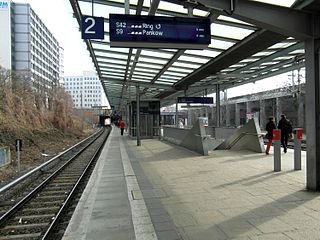
Landsberger Allee is a railway station in the Prenzlauer Berg district of Berlin, close to the district's border with Fennpfuhl. It is served by the S-Bahn lines S41, S42, S8 and S85. The station was named Leninallee in 1950 and has changed name several times since.
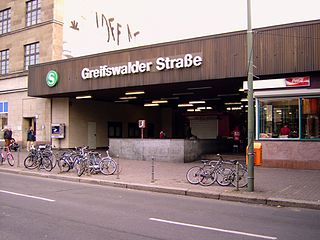
S-Bhf. Greifswalder Straße is a railway station in the Prenzlauer Berg district of Berlin. It is served by the S-Bahn lines S41, S42, S8 and S85.

Prenzlauer Allee is a railway station in the Prenzlauer Berg neighbourhood of Berlin, named after the Prenzlauer Allee road. Situated on the Berlin Ringbahn, it is served by the S-Bahn lines S41, S42, S8 and S85. The station is barrier-free.
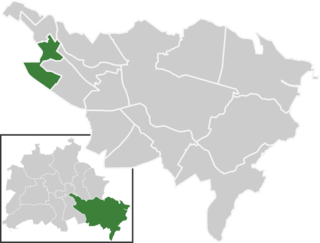
Baumschulenweg is a German locality (Ortsteil) within the Berlin borough (Bezirk) of Treptow-Köpenick. Until 2001 it was part of the former borough of Treptow. Its name means road (weg) of the plant nurseries (Baumschulen). It was named after the Späth nursery.
The U11 line is a planned line of the Berlin U-Bahn.

The DBAG Class 481/482 is an electric multiple unit train for the Berlin S-Bahn. The class 481 was designed to replace the aging rail cars after the German reunification in 1990. The first mock-up models were presented in 1993 with the first rollout on 22 January 1996.

The DR Class 270 was an electric multiple unit of the Berlin S-Bahn. It was designed for the Deutsche Reichsbahn and was intended to be the replacement for the ageing fleet of S-Bahn units in East Berlin. Test runs were started in 1987 and the first batch was delivered in 1990. After German reunification, Class 270 units were reclassified as DBAG Class 485. A second batch was cancelled in favour of a new design, the DBAG Class 481.

The Berlin S-Bahn began on 8 August 1924 with the first section from Stettiner Vorortbahnhof to Bernau using steam locomotives. On 13 August 1961 it was broken up when the Berlin Wall was built, resulting in two sections: the eastern part and the western part. The western part experienced a massive strike which resulted in closure of several stations, after declining use. Attempts were made to reopen at various times but in the end, only three lines were finally opened after the strike. Since 9 November 1989, when the Berlin Wall was opened, the Berlin S-Bahn began to expand rapidly with their budgetary costs.

Deutsche Bahn Classes 483 and 484 are related fleets of electric multiple unit (EMU) trains ordered by German railway operator Deutsche Bahn for use on the Berlin S-Bahn system. They are designed and manufactured by a consortium of Stadler Rail and Siemens Mobility. The first units entered public service on 1 January 2021.















